A History of the County of Buckingham: Volume 2. Originally published by Victoria County History, London, 1908.
This free content was digitised by double rekeying. All rights reserved.
'Parishes: Dinton', in A History of the County of Buckingham: Volume 2, ed. William Page (London, 1908), British History Online https://prod.british-history.ac.uk/vch/bucks/vol2/pp271-281 [accessed 23 April 2025].
'Parishes: Dinton', in A History of the County of Buckingham: Volume 2. Edited by William Page (London, 1908), British History Online, accessed April 23, 2025, https://prod.british-history.ac.uk/vch/bucks/vol2/pp271-281.
"Parishes: Dinton". A History of the County of Buckingham: Volume 2. Ed. William Page (London, 1908), British History Online. Web. 23 April 2025. https://prod.british-history.ac.uk/vch/bucks/vol2/pp271-281.
In this section
DINTON
Daniton (xi cent.); Dunigton (xiii cent.); Donyngton (xiv cent); Dynton (xvi cent.).
Dinton is a large parish in the Vale of Aylesbury and it lies in three hundreds. The village of Dinton and Upton hamlet are in Aylesbury Hundred; Moreton Farm or Liberty is in Desborough Hundred, and Aston Mullins Farm and Waldridge hamlet in Ashendon Hundred.
The River Thame forms part of the northern boundary, and Bonny Brook flows from Marsh hamlet through Dinton parish near Ford. There is water in the grounds of Dinton Hall.
The subsoil is Kimmeridge Clay, Portland Beds and Gault; (fn. 1) the surface soil is Clay, Sand, and Limestone. The occupation of the inhabitants is entirely agricultural, 2,288 acres being laid down in permanent pasture and 1,177¼ in arable land. (fn. 2) Duck and poultry breeding is also carried on. The village of Dinton lies on a side road running parallel to the main road from Thame to Aylesbury, at a short distance to the south. A lower road from Thame also crosses the parish. The nearest railway station is at Aylesbury, 4 miles away, for the Great Western, Great Central, and Metropolitan Extension lines. The common fields were inclosed under Act of Parliament, the award being made in 1804. (fn. 3) Various Anglo-Saxon remains have been found, and are preserved at Dinton Hall. The parish is celebrated for having been the place of residence of two regicides in the 17th century, Simon Mayne at Dinton Hall and Sir Richard Ingoldsby at Waldridge.
John Bigg, joint secretary to the two regicides, also lived at Dinton. Tradition names him as the actual executioner of Charles I. After the Restoration, apparently pursued by remorse, he became a hermit and lived in a cave in the parish, without ever changing his clothes. He died in 1696, and one of his shoes is preserved at Dinton Hall, the other being in the Ashmolean Museum at Oxford. There are four hamlets in the parish: Ford, Upton, Westlington, and Gibraltar. Westlington is the most considerable of these, and lies to the west of the grounds of Dinton Hall, the church and village of Dinton adjoining the same grounds on the east. Upton is a little farther to the north-east, all three settlements being built on the southward slope of the narrow ridge of land along which the Aylesbury road runs. All this part of the parish is very well timbered, especially near the church and Hall. On the southern boundary of the churchyard are some disused almshouses of 18th-century brickwork, with a little timber work of earlier date, the south entrance to the churchyard being by an archway through the buildings. They face on to a pretty green, with the boundary wall of the Hall gardens on the west, and a line of tall trees, beneath which the village stocks and whipping-post yet stand. The road runs on the east side past two small houses with half-timbered gables of early 17th-century date, which are the two wings of an H-shaped house, whose central block has been destroyed, leaving two fireplaces exposed on the wall of the south wing. The hamlet of Ford, as its name implies, lies to the south at the point where the road from Dinton village crosses the Ford Brook, and farther to the south stand the farm-houses of Upper and Lower Waldridge. The small collection of houses known as Gibraltar is on the main Aylesbury road, north-west of Dinton village, and about half a mile to the west of the ridiculous 18th-century ruin known as Dinton Castle, built in 1769 by Sir John Vanhattem. Though in itself of no importance, it stands on a Saxon burial mound from which a number of valuable objects have been dug out. Besides the church there are two buildings of historical interest in the parish, Dinton Hall and Upper Waldridge. Of these the former, said to have been in great part built by Archbishop Warham c. 1500, has been much modernized, but shows a few traces of work as early as the 14th century, though the main part of the building appears to be of 17th-century date. In the cellars, under the present drawing-room, is a curious structure apparently designed to support a projecting fireplace above (the present fireplace is over it), and constructed of arched ribs of stone stiffened by horizontal slabs, and springing from corbels carved with the masks characteristic of 13th and 14th-century Gothic work.
The plan is quite abnormal, the situation, on the side of a fairly sharp southerly slope, probably accounting for this. It is possible that there were at one time wings extending northwards at either end of the existing house, which runs east and west, and is entered from the north. The north face has been much restored in modern times and little or none of the old masonry, whether stone or brick, remains. The entrance doorway opens to a corridor running east and west, at either end of which is a 17th-century staircase. On a level with the corridor are two rooms facing south, the western of which is panelled from floor to ceiling with very fine moulded oak panels of large size and late 17th-century date. In a bedroom over these rooms is a mantel of 16th-century date, with carved ornament which seems a later addition.
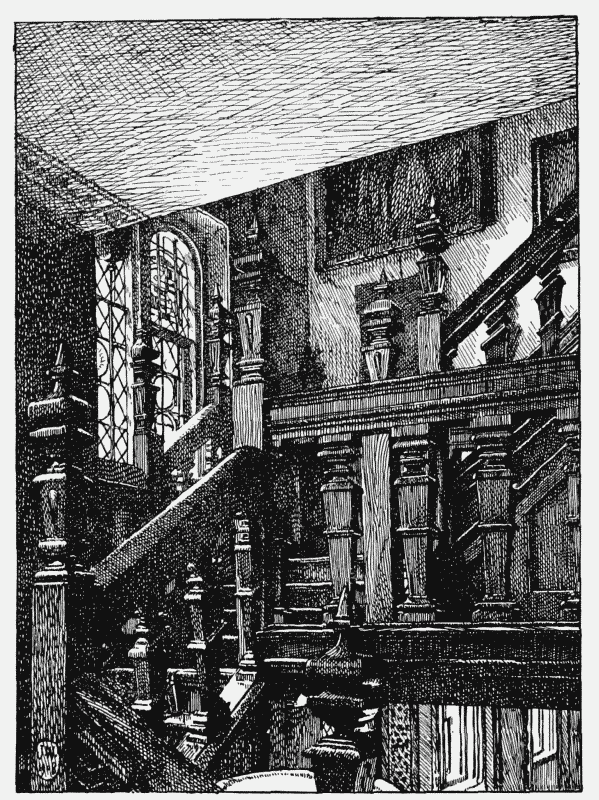
Dinton Hall: The Staircase
East of this central portion are the kitchen and offices, on the north elevation of which is a brick cloister with plain three-centred arches. West of the hall, and at a higher level, is the drawing-room, which has been completely redecorated in comparatively modern times. Opening out of it to the west is a small room of one story, once used as a chapel, and probably mediaeval, though its open timber roof is of 18th-century date, and there are no masonry details of an earlier period now visible. Above the drawing-room is a large room partly in the roof, extending from north to south of the house, in which are preserved a number of curiosities more or less connected with the Hall.
The south front was largely rebuilt in the 18th century, a contemporary drawing showing it fitted with sash windows. In comparatively recent times, however, this front was restored to what must have been, approximately, its original condition, with stone mullioned casements.
Upper Waldridge, now a farmhouse, is a picturesque example of early 17th-century design. The main feature of the plan as it now exists is a large central stack of chimneys, the shafts of which are set anglewise above the tiled roof. Round this the rooms are grouped, opening out of each other with no attempt at corridor or suite planning, the staircase being on the south side. As the house evidently extended farther to the east, it is possible that what remains is one wing and half the main block of an H-shaped house. The original work is all halftimber filled with herring-bone brickwork, but the south and west faces have been refronted later in the 17th century with a thin skin of brickwork, with stone mullioned and transomed windows set in projecting brick panels with ribbed brick cornices and base-moulds. The north gable remains in its original state, and has a very pretty projecting gabled window on the first floor, of five latticed lights with wooden mullions and a transom.
Manors
In the time of Edward the Confessor DINTON was held by Avelin, one of his thegns, but after the Norman Conquest it was granted to the Bishop of Bayeux. (fn. 4) It was assessed in Domesday Book at 15 hides of land. (fn. 5) Bishop Odo lost all his lands under William Rufus, and many of them afterwards came into the possession of the family of Munchesney. Dinton presumably followed the history of Swanscombe in Kent, which belonged to the barony of the Bishop of Bayeux, and was held by the same under-tenant, Helto, in 1086. (fn. 6) Swanscombe was the head of the honour of the Munchesneys, and in the early 12th century was held by Geoffrey Talbot. (fn. 7) He died in 1140 during the civil wars of the reign of Stephen, (fn. 8) and his barony passed to Walter of Meduana. Walter's widow, Cecilia, Countess of Hereford by her first husband, Roger Fitz Miles of Gloucester, Earl of Hereford, and daughter of Payne Fitz John, held his barony after her husband's death. She seems to have been succeeded in the barony by her nephews, the sons of her sister, Agnes de Munchesney, (fn. 9) but in 1185 Agnes herself held Dinton. (fn. 10) In 1190–1 the latter was a tenant in chief in Buckinghamshire, (fn. 11) but she must have died very shortly afterwards. Possibly she held as a sub-tenant of her eldest son, Ralph de Munchesney, (fn. 12) who obtained various privileges in Dinton during the reign of Henry II. (fn. 13) He seems to have died before 1196, when Cecilia, Countess of Hereford, and William de Munchesney, the second son, answered for 29 knights' fees of the honour of Walter de Meduana. (fn. 14) He was succeeded by his son William, a minor in 1204. (fn. 15) The latter only lived till 1213, and was succeeded by Warine de Munchesney, (fn. 16) presumably his brother, who held the manor 'by ancient tenure by the gift of the king.' (fn. 17) He was living in 1253, (fn. 18) but in the next year William de Valence had obtained a grant of the manor. (fn. 19) He had married Joan, daughter of Warine de Munchesney, (fn. 20) and tried to wrest the inheritance from her brother William, of whose lands and person he had custody. (fn. 21) This latter William, however, obtained seisin of his lands, (fn. 22) and died leaving an only daughter Dyonisia. (fn. 23) William de Valence again attempted to get possession of her lands, casting doubts upon her legitimacy. The Bishop of Worcester gave his judgement in favour of Dyonisia, and further efforts to oust her from her inheritance also failed. (fn. 24) She married Hugh de Vere, (fn. 25) but had no children, so that Dinton finally came to the Valences, as the heirs of Joan de Munchesney, Dyonisia died about 1314, (fn. 26) and Aymer de Valence, son of the above-mentioned William de Valence, Earl of Pembroke, and Joan his wife, succeeded to her possessions. (fn. 27) Aymer, some time between 1316 (fn. 28) and his death in 1324, (fn. 29) granted the manor to his wife Mary de St. Paul, Countess of Pembroke, who held it for life. (fn. 30) Subsequently his lands were partitioned amongst the heirs of his sisters, (fn. 31) and Dinton came to Elizabeth Comyn, who married Richard Talbot. (fn. 32) Talbot granted the reversion of the manor to Thomas Talbot, clerk, and his heirs, (fn. 33) and on the death of the Countess of Pembroke in 1377–8 the manor passed to Gilbert Talbot, the great-nephew of Thomas. (fn. 34) Finally in 1384 this Gilbert Talbot granted the manor to Sir John Devereux, (fn. 35) who had already become his tenant for a term of years. (fn. 36) Sir John died in 1392–3, and was succeeded by his son John, a minor. (fn. 37) The latter, however, died three years later, his sister Joan, wife of Walter, Lord Fitz Walter, inheriting his lands. (fn. 38) Joan died in 1409, having survived her husband, and left two sons, Humphrey and Walter. (fn. 39) Humphrey died while still under age, and was succeeded by his brother, who in 1423 sold the manor to John Barton, sen., and John Barton, jun. (fn. 40) The latter died in 1433–4, (fn. 41) having held it in common with John Longville and others, who, however, do not appear to have had any right in the manor after his death. (fn. 42) His sisters were his heiresses, but Dinton was settled on his wife Isabella. (fn. 43) A certain Andrew Sparlyng was seised of the manor to the use of Isabella and sold it to Sir Robert Whitingham (fn. 44) and other feoffees, Isabella holding it for her life by a grant from the new tenants. Sir Robert was a strong Lancastrian partisan, and on the success of the Yorkist cause he forfeited all his lands, which were granted by Edward IV to Sir Thomas Montgomery, first for life and finally in fee-tail. (fn. 45) Margery Whitingham, Sir Robert's heiress, had however married John Verney, the son of Sir Ralph Verney, a Yorkist, who had rendered great service to his party. Consequently many attempts were made to recover the Whitingham lands. Sir Ralph first obtained a grant of the reversion of the manor of Dinton, a prudent measure since Montgomery was elderly and childless. (fn. 46) Long law suits ensued and (fn. 47) the Verneys, on the accession of Henry VII, changed the ground of their claim from the Yorkist services of Sir Ralph to the faithfulness of Sir Robert Whitingham to the Lancastrian cause. John Verney finally obtained his wife's lands, (fn. 48) and his son, Sir Ralph Verney, jun., held them in peace. (fn. 49) The Whitingham and Verney monument in Aldbury Church, Hertfordshire, is a complete record of this phase of the family history. (fn. 50)
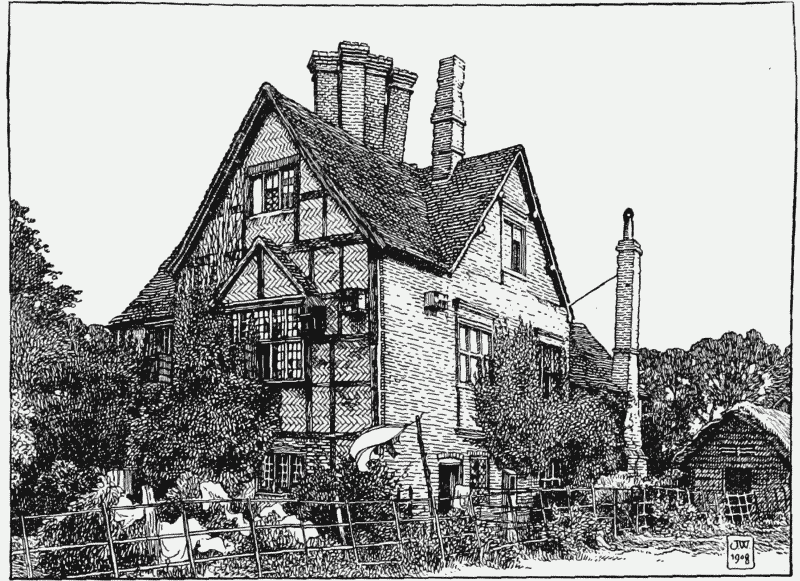
Munchesney. Or three scutcheons barry vair and gules.
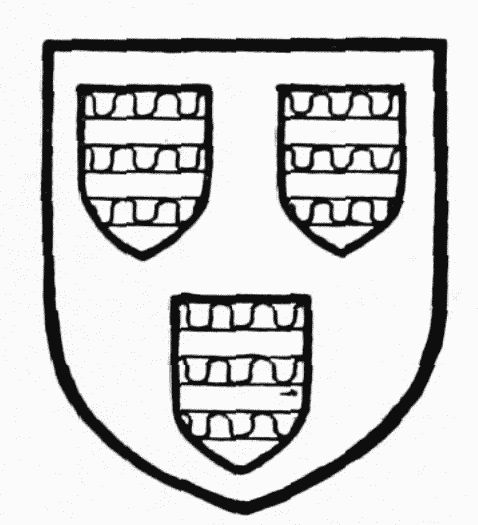
Valence. Burelly argent and azure an orle of martlets gules.
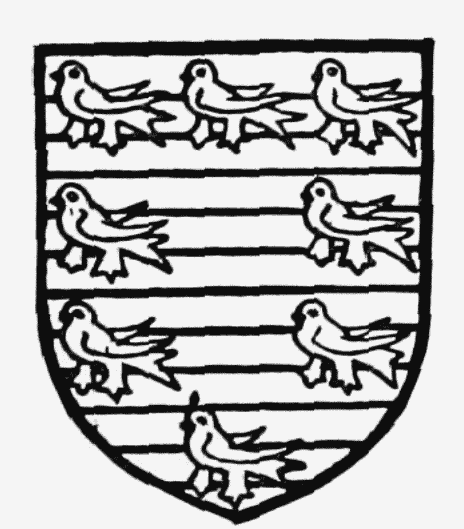
Dinton: Upper Waldridge
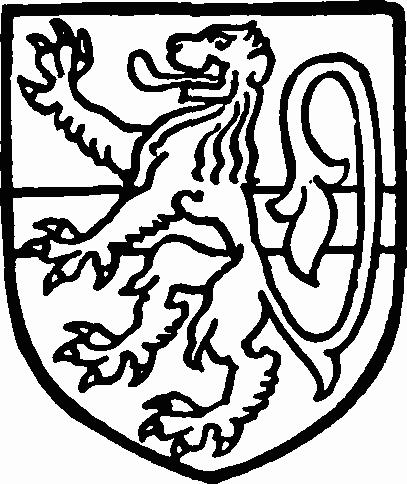
Whitingham. Argent a fesse vert with a lion gules over all.
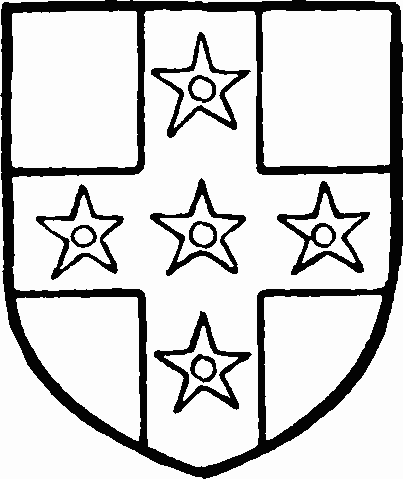
Verney. Azure a cross argent with five pierced molets gules thereon.
Early in the 17th century the Verneys sold the manor of Dinton to Simon Mayne. Between 1585–6 and 1604, Thomas Saunders appears to have had some right in the manor, but presumably only as trustee or mortgagee, (fn. 51) since there is no record at Dinton of his ever being lord of the manor.
Simon Mayne bought the manor in 1604, (fn. 52) but he does not seem to have settled there till two years later. (fn. 53) He was succeeded by his son, Simon Mayne, the regicide, who died in the Tower in 1661. By a special provision he was excepted from enjoying the benefits of the Act of Indemnity and Oblivion passed by the Restoration Parliament, (fn. 54) and his estates were forfeited to the Crown. It seems probable, however, that his son and heir recovered possession of the manor of Dinton. In a dispute as to tithes in 1794 it was stated that Charles II granted the Mayne estates to James Duke of York, but there is no other record of the grant. (fn. 55) Simon Mayne the younger certainly obtained office after the Restoration. He was sub-commissioner of Prizes at Portsmouth till 1689, (fn. 56) and Commissioner of Victualling until the Accession of Queen Anne. (fn. 57) He also sat in Parliament in the reigns both of William III and Anne. (fn. 58) In a petition for a renewal of his Crown lease of the tithes issuing out of 'the demesne lands of the manor of Dinton,' Mayne was stated to be the owner of the lands in question. (fn. 59) This certainly suggests that he had recovered possession of the manor.
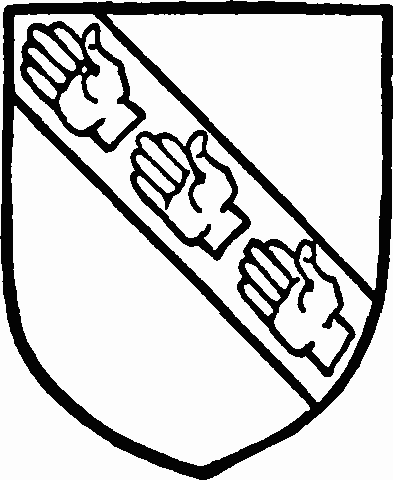
Mayne. Argent a bend sable with three right hands argent thereon.
It is possible that this occurred after the flight of James II, since Mayne represents himself as having been devoted to the Protestant interest. (fn. 60) He died in 1725, and his son, another Simon, inherited the manor, (fn. 61) which he, together with the Hon. Edward Harley, of Iwood, Herefordshire, Auditor of the Imprest, sold to Sir John Vanhattem in 1727. (fn. 62) Sir John Vanhattem died in 1787, and left an only daughter and heiress, who married the Rev. William Goodall. Her descendant, Lieut.-Colonel Goodall, is the present owner of the manor of Dinton. (fn. 63)
The homage of the manors of FORD and WESTLINGTON is said to be included in the manor of Dinton, while a small manor called BLOMERS belonged at one time to the Hampdens, lying intermixed with Ford. (fn. 64) It is said to have passed from the Hampdens to the Claytons and in 1813 was the property of the Earl of Chesterfield. (fn. 65) It now belongs to the lord of the manor of Dinton.
The manor of Dinton was held by military service as one knight's fee. (fn. 66) At one time one mark was paid on St. Nicholas' Day for hidage and suit to the shire court, but this payment was remitted by a charter granted by Henry III either to Warine de Munchesney or William de Valence before 1254. (fn. 67) The latter held the view of frankpledge for his tenants at that date, (fn. 68) and Dyonisia de Munchesney also held the Assizes of Bread and Ale. (fn. 69) In 1253 Warine de Munchesney obtained a grant of free warren for himself and his heirs in the demesne lands of Dinton. (fn. 70)
ASTON MULLINS, otherwise known as ASTON BERNARD, was probably included in the Domesday Survey either in Ilmer or in Aston Sandford. Both these townships were in the hands of the Bishop of Bayeux, and the same under-tenant Robert held both in demesne. (fn. 71) It lay in the hundred of Ashendon. Afterwards Aston Mullins was held with Ilmer, and like Ilmer did not pass to the Munchesney family. How long they remained in the king's hands after the forfeiture of Bishop Odo does not appear, but in the 12th century they were held by the family of Rumenel. (fn. 72)
David de Rumenel held Aston Mullins and died, probably leaving two daughters. (fn. 73) Of these Aubrey married William de Jarpenville, (fn. 74) and brought to her husband her father's office of marshal of the king's falcons. (fn. 75) William died before 1203–4, leaving as his heir his daughter, Alice de Jarpenville. (fn. 76) She married Thomas Fitz Bernard, from whom the manor first took its name, and by grant from Aubrey he became marshal of the royal falcons. (fn. 77)
During the lifetime of Aubrey, Thomas held Aston Mullins, while she kept Ilmer in her own hands. (fn. 78) In 1222 Aubrey de Jarpenville was involved in a lawsuit with Robert Achard, Roger de Cauz, Almaric de Nowers, and Gilbert de St. Clare, who claimed a moiety of Ilmer and Aston as part of the inheritance of David de Rumenel, (fn. 79) their common ancestor. Presumably they were the descendants of the second daughter of David de Rumenel, since they claimed half his inheritance. The suit, however, resulted in their yielding their rights to Aubrey. (fn. 80) She died before 1226, and her daughter Alice succeeded to her lands. (fn. 81)
Ralph Fitz Bernard, the son of Alice and Thomas, recovered his father's lands in 1214 from the hands of Isaac of Norwich, a Jew. (fn. 82) He was succeeded by John Fitz Bernard. Land in Aston Mullins, however, was held by Joan, the widow of Ralph Fitz Bernard, who afterwards married Humbert Pugeys. (fn. 83) John Fitz Bernard was in seisin of the manor in 1254, (fn. 84) but he died a few years later, leaving his son Ralph as his heir. (fn. 85) Ralph was still a minor, (fn. 86) and Humbert Pugeys obtained Aston by a grant of Henry III, presumably to hold in wardship. (fn. 87) In 1284–6 Ralph was himself holding the manor. (fn. 88) He died between 1302 (fn. 89) and 1307, (fn. 90) his heir being his nephew Thomas, a ward of the king. (fn. 91) Aston Mullins formed part of the dower of Ralph's widow Agatha, (fn. 92) but the reversion of the manor on her death was granted by Thomas Fitz Bernard to Sir John Blacket in 1313. (fn. 93) The final conveyance took place in 1315, (fn. 94) and Sir John held it until his death before 1328–9. (fn. 95) His widow Gille married Sir John de Molyns, (fn. 96) and the latter acquired the manor of Aston Mullins from John the son and heir of Sir John Blacket. (fn. 97) De Molyns obtained further security in this manor by releases of their respective rights from John Fitz Bernard (fn. 98) and Giles (fn. 99) and Isabel Blacket. (fn. 100) Various letters patent (fn. 101) and charters from the king were also obtained, one amongst them granting leave to Sir John de Molyns and his wife to embattle the house at Aston Mullins. (fn. 102)
In 1344 the manor was seized by the king with the other lands of Sir John de Molyns, (fn. 103) but the next year he regained the king's favour and obtained fresh grants. (fn. 104) Gille de Molyns died in 1367–8 seised of the manor of Aston Mullins, which then passed to her son Sir William de Molyns. (fn. 105) The family held it until 1440, when Sir William de Molyns died, leaving an only daughter Eleanor. (fn. 106) She married Sir Robert Hungerford, Lord Hungerford and de Molyns. (fn. 107) He was taken prisoner in Gascony during the French War, and to raise his ransom of £3,000 Aston Mullins with various other manors was given in surety to the Bishop of Winchester and other feoffees. (fn. 108) Eleanor, after the death of her husband, had some difficulty in recovering possession of these manors. (fn. 109) Her son Thomas, Lord Hungerford, succeeded to his mother's possessions. He was attainted as a Lancastrian, but the sentence was reversed by Act of Parliament on the accession of Henry VII, and his daughter Mary recovered her inheritance. (fn. 110) She was in the wardship of Lord Hastings, and was married to his son Edward. (fn. 111) The family of Hastings held the manor of Aston Mullins till 1537, when George Hastings, Earl of Huntingdon, and his heir Francis, sold it to Michael Dormer. (fn. 112) Geoffrey Dormer made a settlement of the manor in 1561, by which he was to hold it for seven years, the reversion being granted to Elizabeth, widow of William Serjeant, with reversion to Richard Serjeant her son and his wife Marian Boller. (fn. 113) Marian survived her husband, and held the manor till 1614. (fn. 114) Her son William Serjeant also predeceased her, and Richard her grandson succeeded to the manor. (fn. 115) The Serjeants held Aston Mullins till the 18th century, and the last members of the family who are mentioned as holding it were Jane Serjeant, widow, and Winwood Serjeant. (fn. 116)
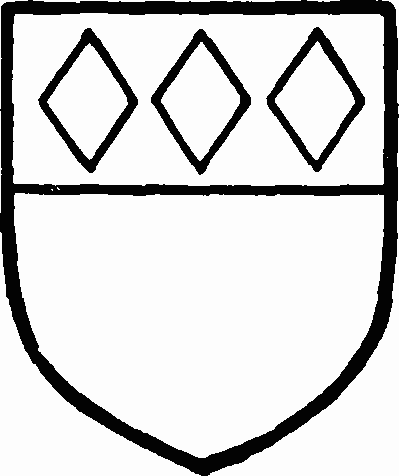
Molyns. Sable a cheif or with three lozenges gules therein.
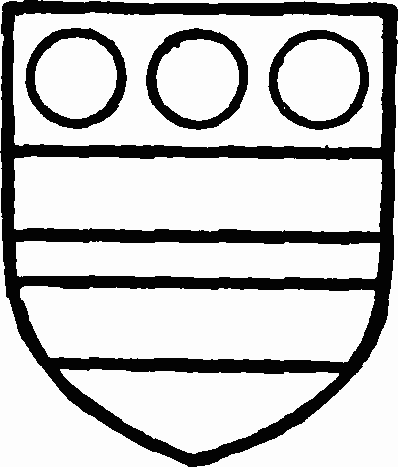
Hungerford. Sable two bars and in the chief three roundels all argent.
In 1793 Matthew Raper and his wife Anne owned the manor, (fn. 117) and in 1827 Henry Raper had succeeded them. (fn. 118) General Raper was lately in possession of a farm called Aston Mullins in Dinton parish, but it has now passed into other hands. (fn. 119)
The manor of Aston Mullins was held in grand serjeanty, together with Ilmer, the holder being the marshal of the king's falcons. (fn. 120) This service was unchanged until the abolition of feudal tenures, the last mention of it being in 1613, on the death of William Serjeant. The manor was then held of the king-in-chief' by the service of serjeanty, viz., Marshal of the goshawks and birds of the King.' (fn. 121) Sir John de Molyns, owing to the high favour in which be stood with Edward III, obtained the grant of many liberties and franchises within his manors, the chief being the return of writs, in-fangthief, outfangthief, gallows; freedom from toll, murage, pavage, and pontage, throughout the kingdom, for himself and his tenants, and free warren in his demesne land. (fn. 122)
Early in the 13th century, a considerable number of alienations of this serjeanty seem to have taken place. Though only Ilmer is mentioned, the alienations in Aston Mullins seem to have been included under this heading. Robert Passelewe, in the reign of Henry III, recovered these alienations for the king. The tenants paid a fixed yearly rent, while military service was substituted for serjeanty. (fn. 123)
Robert Pykoc held 1½ virgates of land and pasture of this serjeanty, and had also granted another half virgate to Richard Pykoc. (fn. 124) This land was probably in Aston Mullins, since a conveyance was made between John Pykoc and Robert Pykoc of messuages and land in Aston Mullins and Waldridge in 1310. (fn. 125)
After the Norman Conquest Miles Crispin obtained the grant of 1½ hides of land in Upton, (fn. 126) the origin of the estate of NETHER UPTON. In the Confessor's time it had been held by a thegn named Albric, and he remained in possession of this land as a sub-tenant of Miles Crispin. (fn. 127) The lands of Miles Crispin, together with those of Robert Doyly afterwards formed the royal honour of Wallingford, (fn. 128) to which this part of Upton belonged. (fn. 129) In the 12th century William de Upton appears to have been the tenant of this land. In 1197 there was a lawsuit between Samson de Ie Pomerae and his wife Christian and William as to the service due from 6 virgates of land in Upton, of which Samson appeared to be the mesne tenant between William de Upton and the honour of Wallingford. (fn. 130) Geoffrey, son of William or Geoffrey de Upton, succeeded his father, (fn. 131) but in 1235 another William de Upton paid the feudal dues from the land. (fn. 132) He was succeeded by Geoffrey de Upton, (fn. 133) who, however, granted all his land in Upton to William Giffard in 1267. (fn. 134) The heirs of Geoffrey de Upton attempted to recover their possession and seized the land. (fn. 135) Long law-suits ensued, the pleadings being rather obscure. The jurors said that Geoffrey de Upton never enfeoffed William Giffard with the tenements in question, namely, one messuage and 183 acres of land, 8 acres of wood, and 8 acres of meadow, but that the latter entered on the tenement shortly after the battle of Evesham. William demised it to Adam de Caudes for life, but afterwards resumed it into his own hands. (fn. 136) In spite of this evidence it was acknowledged that in 1267 Geoffrey de Upton came before the Chancellor and quit-claimed for himself and his heirs his manor of Upton to William Giffard. (fn. 137) Geoffrey's heirs were two nieces, Cecilia de Gatesdon and Alice Haket, and John de Middleton, John de St. Owen, and Robert Covert. The three last-named were presumably the nephews of Cecilia and Alice. (fn. 138) Finally William Giffard appears to have recovered possession of the manor. (fn. 139) During the disseisin of Giffard, John de Middleton and his co-parceners enfeoffed John le Waleys and his wife Maud with half of the land in question. After the death of John, Maud married Simon de Kingesmede. (fn. 140) In 1290 they were disseised of their land by Hamo Hawtrey, the descendant of William Giffard. (fn. 141)
They petitioned the king, and presumably recovered seisin, since in 1302–3 Master William Bernel and Simon de Kingesham (or Kingesmede) (fn. 142) held this part of Upton. In 1346 it was held by Michael atte Watre and John le Waleys, (fn. 143) the son and heir of John le Waleys and Maud. (fn. 144)
The later history of Nether Upton cannot be traced. In 1346 John de Handlo died seised of rents in Upton by Aylesbury, which he held of the honour of Wallingford. (fn. 145) Hence the land from which they were paid was presumably in Nether Upton. His heir was a minor, Edmund, son of Richard de Handlo. (fn. 146) Edmund died before 1363, and his lands were divided between his two sisters Margaret the wife of Sir John Appleby and Elizabeth the wife of Edmund de la Pole. (fn. 147)
The land in Upton belonging to the honour of Wallingford was held as the twentieth part of a knight's fee. (fn. 148)
Before the Norman Conquest Alwin, a thegn of Queen Edith, held 3½ hides of land in UPTON, which he could sell as he pleased. (fn. 149) At the time of the Domesday Survey this land had passed to William Peverel, (fn. 150) and formed part of the honour of Peverel of Nottingham. (fn. 151) William Peverel had granted this land to a sub-tenant named Robert, (fn. 152) but later it was held by the family of Hussey.
The first mention of Upton after the entry in Domesday Book occurs in 1207, when one knight's fee in Upton was in the king's hands, but three years earlier William Hussey held one fee in the county. (fn. 153) About 1210 Henry Hussey held Upton, (fn. 154) and in 1211 or 1212 William Hussey is mentioned as the tenant. (fn. 155)
Not long after this, however, another Henry Hussey held it. (fn. 156) In 1302–3 it was held by a sub-tenant of his heir, (fn. 157) but after this the name of Hussey does not appear in connexion with land in Upton.
Henry Hussey granted his fee in Upton to the abbey of Oseney. (fn. 158) This grant was confirmed in 1238, (fn. 159) and in 1276 the abbot was said to hold the manor of Upton of Henry Hussey, doing suit at the court of the honour of Peverel. (fn. 160) In 1346, however, he held a knight's fee in 'Upton cum Stone' of the king in chief, (fn. 161) and it belonged to the abbey till its dissolution. (fn. 162) The manor of Upton was granted in 1541 to Sir John Baldwin, Chief Justice of Common Pleas. (fn. 163) In his will it was left to the king 'for the wardship and primer seisin' of his heirs, Thomas Pakington and John Borlase. (fn. 164) The latter was the son of the younger daughter of Sir John, and Upton formed part of his share of the inheritance. (fn. 165) The Borlases held the manor (fn. 166) until the death of Sir John Borlase, bart., without heirs male in 1688–9, (fn. 167) when the four daughters of his uncle, William Borlase, inherited Upton. (fn. 168)
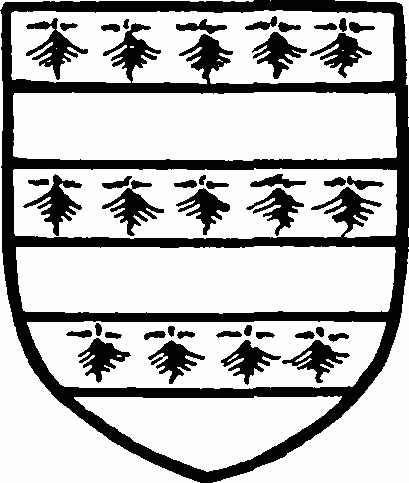
Hussey. Barry ermine and gules.
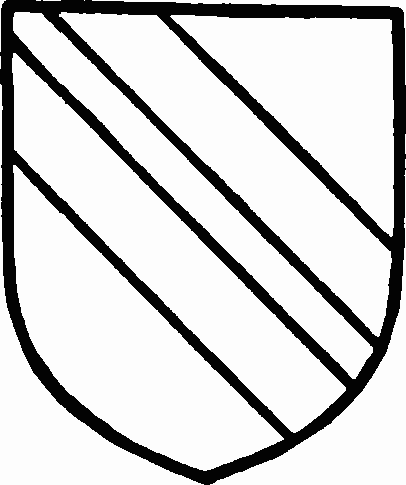
Oseney Abbey. Azure two bends or.
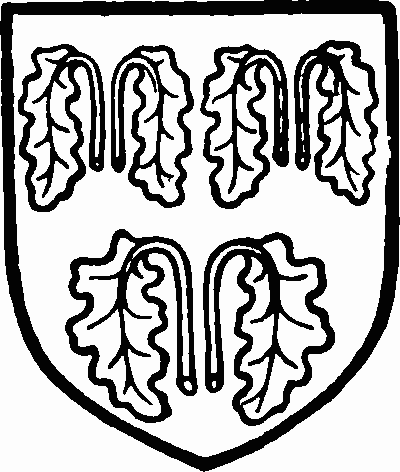
Baldwin. Argent three pairs of oakleaves vert with stalks sable.
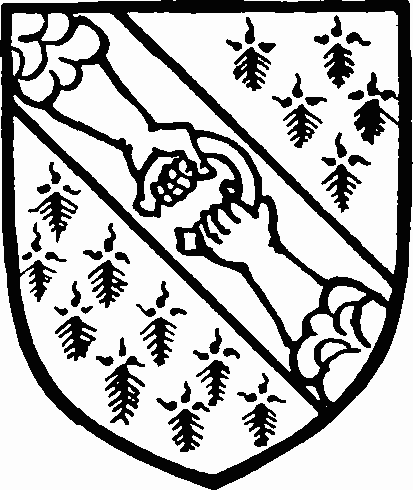
Borlase. Ermine a bend sable and thereon two arms coming out of clouds, the hands grasping a horseshoe or.
John Wallop, who had married Alice, the eldest sister, apparently bought the other three shares of the manor. His second son John, who afterwards became Earl of Portsmouth, inherited it in 1762. (fn. 169) The second earl held it in 1789–90, (fn. 170) and his son and successor was said to hold it in the first part of the 19th century. (fn. 171)
Upton is at the present day a sub-manor appendant to the manor of Dinton, the land being owned by Mrs. Parker. (fn. 172)
The manor of Upton was held by the military service due from one knight's fee. (fn. 173) The Abbot of Oseney held it in frankalmoign of Henry Hussey and his heirs, paying 5s. a year (fn. 174) at Michaelmas. This rent was afterwards paid to the bailiffs of the honour of Peverel. (fn. 175) The abbot, however, was answerable for the service due to the honour, and paid the feudal dues from his fee. (fn. 176) In 1254 the bailiff held the view of frankpledge, pleas of namio vetito, and the return of writs within the manor. (fn. 177) The abbot claimed the view of frankpledge and waifs in the reign of Edward I. He presented a charter of Henry III, which confirmed rights granted by Henry II as warranty, but he renounced his claim to waifs. (fn. 178) The Borlase family and their successors also claimed to hold the view of frankpledge and a court-leet in their manor of Upton. (fn. 179)
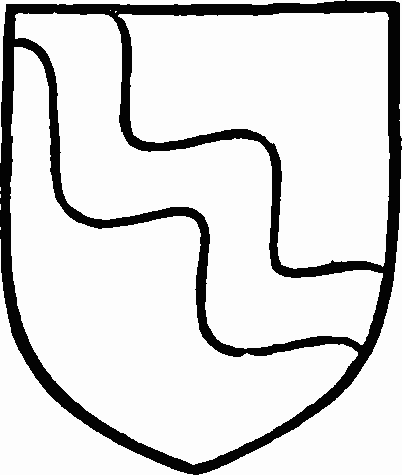
Wallop, Earl of Portsmouth. Argent a bend wavy sable.
In the time of Edward the Confessor two socmen held WALDRIDGE. They were respectively the men of Avelin and of Alveva, sister of Earl Harold, and they could sell their land at will. (fn. 180) After the Conquest this land, containing I hide and 2 virgates, was granted to the Bishop of Bayeux. (fn. 181) It passed with the manor of Dinton in succession to the Munchesneys (fn. 182) and the Earl of Pembroke; (fn. 183) the last mention of the overlordship of Waldridge occurs in 1316, and was then held by Aymer de Valence, Earl of Pembroke. (fn. 184)
Helto, the steward of the Bishop of Bayeux, held Waldridge as an under-tenant in 1086. (fn. 185) In 1254, 9 virgates of land were held by John de Stoke and Richard de Middleton. (fn. 186) Geoffrey de Upton also held 3 virgates of land, but his overlord was said to be Adam Rumbald. (fn. 187) No further mention of this mesne tenancy appears. Geoffrey, how ever, held more land in Waldridge, (fn. 188) and in 1267 he granted it as a member of the manor of (Nether) Upton (q.v.) to William Giffard. (fn. 189) The latter, together with John le Waleys, held 11 virgates of land in 1284–6. (fn. 190) The heirs of Geoffrey de Upton attempted to recover Waldridge as well as Upton (q.v.), with presumably the same result, and its history at that time is very obscure. (fn. 191) Five virgates of land in Waldridge were granted by Edward IV to Sir Thomas Montgomery in 1464. (fn. 192) The reversion in the event of his dying without heirs male was obtained by Ralph Verney and Richard Fowler. (fn. 193) The manor of Waldridge, however, came into the possession of the Hampdens. In 1487 Margery, the widow of Thomas Hampden, claimed a third as her dower and recovered her seisin. (fn. 194)
Land in Waldridge was held by the family until the death of Sir Alexander Hampden, (fn. 195) a fine of messuages, lands, and rents in Waldridge being levied in 1622 between two of his heiresses, Anne the wife of Sir John Trevor, and Margaret the wife of Sir Thomas Wenman. (fn. 196)
The manor, however, appears to have come into the possession of the Serjeants before this time. In 1615 William Serjeant died seised of a capital messuage or farm in Waldridge. (fn. 197)
In 1650 Sir Richard Ingoldsby the regicide purchased the manor of Waldridge from the Serjeants and lived there. (fn. 198) The family remained as residents in the parish for many years, and presumably held the manor of Waldridge.
In 1849 it was purchased by the lord of Dinton Manor, the father of Lieut.-Col. Goodall, and is now appendant to the main manor. (fn. 199)
In 1254 John de Stoke and Richard de Middleton paid 20s. a year to Warine de Munchesney for the 9 virgates that they held of him. (fn. 200) They held the view of frankpledge for their tenants, but made a yearly payment of 2s. to the king for this right. (fn. 201) Geoffrey de Upton, however, paid 15s. a year to his immediate lord, and did no forinsec service to the king. (fn. 202)
The manor or liberty of MORETON belonged to the hundred of Desborough. It is not mentioned separately in the Domesday Survey, but it may have been included in West Wycombe, (fn. 203) since it was afterwards held by the Bishop of Winchester, (fn. 204) and was appendant to his manor of West Wycombe. (fn. 205) Bishop Richard Pope held a court-leet for Moreton in the reign of Henry VII, (fn. 206) but in 1551 Bishop Poynet surrendered his manors of West Wycombe, Moreton, and Ivinghoe to the king. (fn. 207) The two last-mentioned manors were, however, restored to the see of Winchester. The bishop held the manor in 1613, (fn. 208) and in 1797 it still belonged to the bishopric. (fn. 209) Moreton was held in frankalmoign of the king in chief. (fn. 210)
John Duncombe held a capital messuage in Moreton in the 16th century. (fn. 211) It passed into the hands of John Saunders of Long Marston, Hertfordshire, who sold it to Richard Saunders. (fn. 212) The latter died in 1601, leaving a son John as his heir, (fn. 213) from whom Robert Waller bought two messuages, a garden, an orchard, and 90 acres of land in Moreton and Dinton. (fn. 214) Edmund Waller was his son and heir, but was a minor at the time of his father's death in 1617. (fn. 215) His descendant, Edmund Waller, held Moreton under the Bishop of Winchester in 1797, (fn. 216) and the Wallers still own Moreton at the present day. (fn. 217) In 1606 Sir Thomas Lee died seised of a farm called Moreton Farm in Dinton, which had previously been held by Edmund Waller. (fn. 218) How Sir Thomas had obtained this farm does not appear, nor the date of its recovery by the Wallers. Moreton is, however, best known as the first place of residence of the Lees in Buckinghamshire. Thomas and Ralph Lee held lands in Moreton, which they granted on lease to Francis Lee for twenty-six years. (fn. 219) Thomas Lee, the son of the lessee, held the remainder of this lease at the time of his death in 1572. (fn. 220) He left in his will the house in which he lived at Moreton to his wife, together with all lands belonging to it and other tenements there. (fn. 221) The Lees had probably settled there in the 15th century, a brass to William Lee, of Dinton, who died in 1485, still existing in the church.
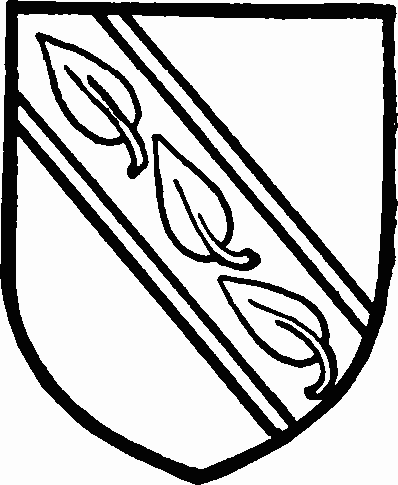
Waller. Sable three walnut leaves or between two bends argent.
The family of Compton held land under the Bishop of Winchester in the 15th century. There is a brass in Dinton Church commemorating members of the family, and bearing the date 1424, and John Compton held land in Moreton in 1407. (fn. 222) Sir Ralph Verney (jun.) died seised of COMPTON'S MANOR in 1525 and it formed part of the jointure of his wife Elizabeth. (fn. 223) His son and heir Ralph succeeded him. (fn. 224) William Serjeant, however, held this manor at the beginning of the 17th century. (fn. 225) Compton's Piece and Compton's Lane are mentioned in 1714, (fn. 226) and Compton's Farm is mentioned in the early part of the 19th century. (fn. 227)
The tenure by which the Comptons held their land does not appear. Sir Ralph Verney, however, held the manor of the Bishop of Winchester, (fn. 228) and William Serjeant held it of the bishop as of his manor of Moreton by fealty and a yearly rent of 16s. (fn. 229)
Church
The church of ST. PETER and ST. PAUL consists of a chancel 39 ft. by 17 ft. 8 in.; a nave 56 ft. 9 in. by 23 ft. 1½ in.; a south aisle 14 ft. 3 in. wide with south porch, and a western tower 15 ft. 2 in. by 12 ft. 2 in. The church seems to have been almost entirely rebuilt in the 13th century, but the walling above the south arcade is probably older than the arcade, and at the east end a shallow pilaster buttress shows in the east wall of the south aisle, which looks like 12th-century work. The south doorway is also of this date, and was doubtless removed to its present position from the wall of an aisleless nave.
In the first half of the 13th century the nave was brought to its present plan by the rebuilding of its north wall, perhaps a little outside the line of the former north wall, and the addition of the south aisle and its arcade. The present chancel arch was built about the same time, and the chancel was rebuilt as it now appears, except in the matter of length. This has been increased by some feet in modern times.
In the north wall of the nave pilasters were set to take the ends of the roof timbers, corresponding with the spacing of the south arcade, but all the windows of this date have been replaced by later work. At some time in the 14th century four buttresses were built to support this wall, spaced symmetrically on the outer elevation, without regard to the pilasters within, and in the 15th century three large square-headed windows were inserted, also set with regard to the outside elevation, as far as the internal pilasters allowed. The tower is of the 15th century, the 13th-century west door of the nave being removed to serve in the west wall of the tower, and the south porch is also of the 15th century. The church is covered externally by an almost complete coat of rough-cast, the only part not so treated, the chancel, having been largely re-pointed and re-faced in modern times. The church was 'restored' by Street in 1868.
The east windows of the chancel, three lancets, are entirely modern. There are three lancets also in the north and south walls, which though re-tooled are in the main old. The south doorway, between the first and second lancets, is also in part old, and now blocked with masonry. At the east end of the north wall is a square locker rebated for a door, and in the same position on the south a much-scraped and restored piscina of 13th-century date with a trefoiled head and label. At the west end of the south wall is the opening of a squint which passes through the south respond of the chancel arch, giving a view of the former position of the high altar from the south aisle.
The chancel arch appears to be of the same build as the nave arcade, and is of three plain chamfered orders set centrally with both nave and chancel. The responds are semi-octagonal with moulded capitals and bases, the abaci being continued as a string across the west face of the wall, and ranging with those of the south arcade. The pilasters in the north wall are semioctagonal and very slender in form, with small moulded capitals, which are probably 15th-century additions to take the feet of the wall brackets of the principals, a purpose they continue to fulfil in the case of the modern roof. The south arcade is of five bays with octagonal columns having moulded capitals and bases; the arches are of two chamfered orders struck from a point well below the springing line. All the north windows are square-headed, the first from the east being of two trefoiled lights under a square head; it is of the same section as the others in the wall, though its tracery has a somewhat earlier character. The others are three in number, with ogee cinquefoiled lights under a square head with small quatrefoils in the spandrels. Above the crowns of the three eastern bays of the south arcade are 15th-century clearstory openings with quatrefoil heads in a square frame, the wall above the arcade being set out on a chamfered string on account of the irregularity of the old wall face below.
The east window of the south aisle is of three trefoiled lights, with tracery of 15th-century detail, and almost entirely modern. At the east end of the south wall is a piscina with a hollow-chamfered two-centred head and an old drain, and above it a much restored three-light 15th-century window with modern tracery. The south door, nearly opposite the middle bay of the south aisle, is of 12th-century date, c. 1140–50, a very fine specimen, with a semicircular arch of two orders with zigzag ornament, a continuous label with triple billet ornament, spirally fluted shafts to the inner order, and a carved tympanum and lintel. The capital of the western shaft is scalloped, and that of the eastern has a bird with outspread wings.
On the tympanum is a conventional tree between
two monsters, and on the lintel below are St. Michael
and the Dragon, the underside of the lintel and the
upper border of the tympanum having bands of interlacing ornament. On the lower part of the tympanum and the upper edge of the lintel is the inscription
+ Premia Pro Meritis si Q(u)is Desp(er) Et Habenda
Audiat Hic Prec(e)pta Sibi Qve Si(n)t Retinenda +
The jambs of the inner order appear to have been
altered, and have stops of modern classical character
immediately below the lintel.
West of the door is a three-light 15th-century window of the same design as that on the east of the door, and, like it, much restored. The west window, of two lights with tracery of 15th-century design, is almost completely modern, the sill and a few stones in the jambs alone being old. The porch has a good 15th-century roof with moulded timbers resting on four stone carved corbels; the inner tie-beam being cut away to show the details of the inner doorway.
The tower is of three stages, with an embattled parapet and belfry windows of two trefoiled lights with a quatrefoil in the head. The tower arch is two centred, of three chamfered orders, dying out at the springing. The west window of the ground stage is of 15th-century date, with three cinquefoiled lights and tracery over in a four-centred head. The west door has a two-centred head of three deeply-moulded orders and double-shafted jambs, the inner order being continuous. The label has mask drips, and the doorway is a fine piece of 13th-century detail.
The font has a large cup-shaped bowl on a wide circular moulded base, and much resembles in outline a type of late 12th-century font common in the neighbourhood. The base appears to be of that date, but the details of the bowl look like 14th-century work, and it is possible that it is in reality a 12th-century font recut. It has a scroll moulding on the lip, and below it a band of quatrefoiled circles, the lower part of the bowl being fluted, with trefoiled ogee heads to the flutes.
The roofs, except that of the porch, are modern, those
of the nave and aisle being of low pitch and covered
with lead, while that of the chancel is of steep pitch and
tiled. The seating is also modern, but there is a fairly
good 17th-century pulpit, and in the vestry, at the west
end of the aisle, is a table with large carved baluster
legs dated 1606, and an inscription cut on the top,
Francis Huntts Geven By The Youth Of Upton
the initials, presumably, of the donors being cut on the
front of the frame. There is also a chest with linen
panels and styles carved with detail of c. 1540, but
a lid of 17th-century date, and under the tower a
cupboard made up of similar materials. At the northeast of the nave is a tablet to Simon Mayne of Dinton,
1617, who married Collubery, the daughter of Richard
Lovelace of Hurley, Berkshire, and had one son and one
daughter. In the tower is a small wall monument to
Richard Ingoldsby, 1703, his wife Mary (Colmore),
seven sons and seven daughters. In the same place is
a large monument of black and white marble with Ionic
columns carrying an arched pediment, commemorating
Richard Serjeant, 1661, and his two wives Anne (Ingoldsby) and Jane (Harrington); on the plinth is an
inscription to the last with blanks left for the age and
date of death. Above are the arms: Gules a bend
wavy argent between two dolphins or impaling Sable
fretty argent, which are the arms of his second wife.
In the floor at the west end of the south aisle are the
following brasses: John Compton, 1424, and his wife
Margery (Hurley), with four sons and five daughters;
William Lee of Moreton in the parish of Dinton, 1486,
and Alice his wife; John Lee of Moreton, 1500 (inscription plate only); Francis Lee, 1558, and Elizabeth
his wife; Elinor, wife of Sir Thomas Lee of Moreton, who had twenty-four children and died 1633;
Simon Mayne, 1617, and Collubery his wife, 1628
(see above); Thomas Grenewey, 1538, and his wife
Elizabeth, 1538; and their son and heir Richard
Grenewey, 1551, and his wife Joan (Bulney). On
the last named are the arms of Grenewey: Gules a
fesse and a chief or with three martlets vert in the
chief. In the chancel are some 18th-century monuments to the Vanhattem family. Under the tower
hangs a funeral helm of 16th-century type. In the
south-east window of the south aisle is a shield of
old glass bearing Barry … in chief three griffins'
heads.
There are six bells; the treble, second and third of 1656, the fourth by Richard Chandler, 1682, the fifth of 1658, and the tenor of 1892. The bells of 1656–8 are from the Knights' foundry at Reading.
The church plate is very handsome, and consists of a large covered cup of Elizabethan design bearing the date letter for 1569; a salver inscribed as the gift of Thomas Ingoldsby in 1721 and hall-marked for that year; and two large flagons, the gift of Sir John Vanhattem in 1772, hall-marked for 1771.
The first book of the registers contains all entries between 1562 and 1648; the second all between 1653 and 1742, and a third book contains burials in woollen from 1689 to 1737. After 1742 there is a gap, baptisms and burials being continued in one book from 1773 to 1812, while two books contain the marriage entries between 1754 and 1768, and 1768 and 1812.
Advowson
The church of Dinton was granted by Agnes de Munchesney to the convent of Godstow, Oxfordshire, in the reign of Henry II. (fn. 230)
The rectory was impropriated and the vicarage ordained by the time of Bishop Hugh of Wells. (fn. 231) After the dissolution of the convent, Henry VIII in 1545 granted the rectory and church with the advowson of the vicarage to Robert Brown, Christopher Edmesdes, and William Windlow. (fn. 232) They enfeoffed Robert and John Doyley, (fn. 233) the former of whom sold the rectory and advowson in 1556 to Richard Shrimpton. (fn. 234) From Shrimpton they passed to John Duncombe, (fn. 235) who together with his son Edward granted the rectory, (fn. 236) and apparently the advowson also, to Elizabeth, the wife of Richard Saunders, for life, with remainder to Richard and to his son John. (fn. 237)
After the death of her first husband Elizabeth married Sir — Hoddesdon, (fn. 238) and John Saunders seems to have entered into possession of the rectory and advowson. (fn. 239) The latter he granted separately in 1623, with the consent of his mother, to William Carter of Offley, Hertfordshire. (fn. 240) John died in the same year, leaving an only daughter Elizabeth, aged seven at the time of her father's death. (fn. 241) She probably married Sir Walter Pye, (fn. 242) and they were in possession of the advowson of the church of Dinton in 1639. (fn. 243) Elizabeth died seised of the rectory and advowson, which were inherited by her son Walter. (fn. 244)
He sold the advowson of the vicarage about 1650 to Simon Mayne the regicide, (fn. 245) so that after the Restoration it was forfeited to the Crown. It was not alienated, (fn. 246) and the patronage of the vicarage of Dinton is in the hands of the Lord Chancellor at the present day.
The rectory was not sold by Sir Walter Pye with the advowson, but he conveyed it to John Harrington and Richard Serjeant (jun.) in 1655. (fn. 247)
The warrant for a grant of the rectory and tithes of Dinton was made out in 1662 to the Bishops of London and Winchester and others, to be held in trust for the maintenance of a minister. (fn. 248) The rectory was then said to have come to the Crown by the forfeiture of the lands of Simon Mayne; (fn. 249) but this presumably was a mistake, since he does not seem ever to have bought the rectory. In 1705 Winwood Serjeant and his wife Martha held the rectory, hence his family had presumably owned it without interruption since its purchase in 1655. (fn. 250)
There is a Baptist chapel at Ford in this parish, built in 1716, with a mission chapel attached to it at Dinton.
Charities
Dame Elizabeth Hoddesden, who died 11 March 1637, by will left £15, the interest to be given yearly on the day of her death to ten or twelve poor old persons by the direction of the minister and churchwardens. The principal sum appears to have been received and spent by the parish, but no sum by way of interest has been distributed for many years.
Mrs. Matilda Phelps by will, proved in 1867, left £100 to be invested and income applied by the vicar of Dinton, and the owner of Dinton Hall, in the distribution of coals to poor and aged widows and spinsters. The legacy is represented by £103 18s. 9d. India 3 per cent. stock with the official trustees. The dividend, amounting to £3 2s. 4d., was in 1905–6 distributed in coal to eight widows and two spinsters.
In 1876 Miss Eliza Goodall by will left £200 consols (with the official trustees), the dividends to be applied annually in the month of January for the benefit of all or such of the poor as should be then residing in the cottages known as the 'Church Houses,' and in such shares as the owner of the Dinton Hall estate should think well. By a scheme of the Charity Commissioners, 1901, it was provided that so long as there should be no inmates of the Church Houses the income should be applied for the benefit of deserving and necessitous persons in such way as might be considered most conducive to the formation of provident habits. In 1906 coal, articles of clothing, and money were distributed to twenty recipients.
Mrs. Sarah Maria Clotilda Roper by will 1866, proved in 1881, among other charitable legacies, bequeathed specific sums and share of residue for the benefit of this parish. The estate was administered in the Chancery Division of the High Court, and in the result £89 consols (with the official trustees) and £450 17s. 4d. consols (in court) were assigned for the benefit of the organist; £89 15s. 6d. consols (with the official trustees) for the poor; £558 3s. 5d. consols (in court) for the poor schools; and £507 17s. 5d. consols (in court) for the benefit of the Dinton schoolhouse. The amount applicable for educational purposes, about £26 a year, is received by the national schools.